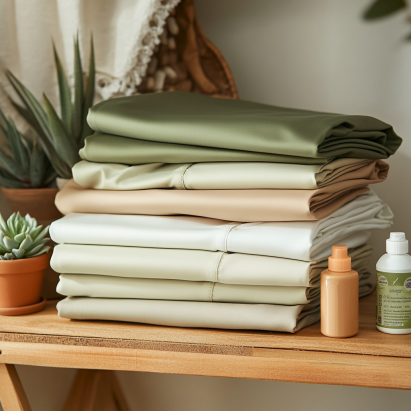Eco-Friendly Sleep Choices: Sustainable Bedding Options
Looking to reduce your carbon footprint while enhancing sleep quality? This guide explores top Eco-Friendly Sleep Choices—from sustainable materials to trusted brands—so you can create a healthier, eco-conscious bedroom. Whether you’re starting your green journey or refining an already sustainable lifestyle, your bedding choices directly impact both your sleep and the planet.
Key Takeaways: Eco-Friendly Sleep Choices
- Eco-Friendly Sleep Choices improve sleep quality and support environmental health.
- Opt for organic cotton, linen, bamboo, and TENCEL™ Lyocell for sustainable comfort.
- Choose duvets and comforters with RDS certification or recycled fills.
- Understand eco-friendly vs. organic vs. natural vs. sustainable bedding differences.
- Support brands that prioritize transparency, non-toxic materials, and ethical production.
Why Choose Eco-Friendly Sleep Choices?
Eco-friendly bedding enhances your rest while reducing your environmental footprint. By choosing renewable and responsibly produced fabrics, you minimize waste, avoid harmful chemicals, and support fair labor practices. Unlike conventional synthetics, sustainable bedding lasts longer and delivers healthier sleep.
Investing in quality bedding also means fewer replacements, saving money over time.
Eco-Friendly vs. Natural vs. Organic vs. Sustainable Bedding
The terms overlap but carry distinct meanings. Eco-friendly is the broadest, describing products that minimize harm. Natural bedding uses plant or animal fibers but may still contain chemicals. Organic bedding is certified chemical-free, while sustainable options consider the entire lifecycle, from sourcing to disposal.
For example, a duvet made from recycled plastic bottles is eco-friendly, but not natural or organic. Meanwhile, GOTS-certified cotton is both organic and sustainable.
| Term | Definition |
|---|---|
| Eco-Friendly | Minimizes environmental harm through materials or practices |
| Natural | Derived from plants or animals with minimal processing |
| Organic | Certified chemical-free, grown without pesticides |
| Sustainable | Considers full lifecycle impact, including waste and renewability |
Eco-Friendly vs. Conventional Bedding
Conventional bedding often relies on synthetic fibers like polyester, which are petroleum-based, non-biodegradable, and contribute to microplastic pollution. In contrast, eco-friendly bedding materials like linen, organic cotton, and bamboo lyocell decompose naturally and use significantly less water and energy during production.
Choosing the right material ensures both comfort and sustainability.
Environmental Impact of Bedding Choices
Your bedding choices affect carbon emissions, water use, and long-term waste:
- Carbon footprint: Organic cotton emits up to 46% less CO₂ than conventional cotton farming.
- Water use: Conventional cotton needs ~2,700 liters of water per sheet set, while organic cotton uses 91% less.
- Biodegradability: Linen, wool, and organic cotton naturally decompose, unlike polyester which lingers for centuries.
Sustainable Materials for an Eco-Conscious Bed
Building an eco-friendly bed starts with materials that balance comfort and sustainability:
- Organic Cotton: Breathable, hypoallergenic, and grown without pesticides.
- Linen: Antibacterial, durable, and water-efficient.
- Bamboo Lyocell: Silky, breathable, and closed-loop processed.
- TENCEL™ Lyocell: Sustainably harvested, moisture-wicking, and toxin-free.
- Wool: Natural insulator, biodegradable, and temperature-regulating.
Buyer’s Guide: Certifications to Look For
To avoid greenwashing, rely on certifications:
- GOTS: Global Organic Textile Standard ensures organic farming and ethical production.
- OEKO-TEX: Tests for harmful substances in textiles.
- RDS: Responsible Down Standard guarantees humane treatment of animals.
- FSC: Forest Stewardship Council certifies responsibly sourced wood for TENCEL™.
Creating an Eco-Friendly Bed: Principles and Tips
Transition to eco-friendly bedding gradually. Replace items as they wear out, invest in durable materials, and choose natural fiber layers for year-round comfort.
Temperature-regulating bedding also reduces reliance on heating or cooling systems, cutting energy waste.
Best Sustainable Bedding Brands
Some leading brands include:
- Coyuchi: Organic, GOTS-certified, cradle-to-cradle sustainable.
- Looma: Fair-trade cotton sheets with eco-friendly farming.
- Avocado: Organic bedding paired with eco-certified mattresses.
- The Citizenry: Artisan-crafted, ethically sourced.
- Textilwerk & Grüne Erde (EU): Traditional craftsmanship with organic materials.
FAQ: Eco-Friendly Sleep Choices
- What makes bedding eco-friendly?
- Eco-friendly bedding uses sustainable, recyclable, or biodegradable materials and minimizes environmental impact through responsible production.
- Is organic cotton better than regular cotton?
- Yes. Organic cotton avoids pesticides, is gentler on skin, and requires less water, making it safer for both the environment and personal health.
- How can I make my bedding routine more eco-conscious?
- Wash in cold water, use biodegradable detergents, line dry when possible, and avoid synthetic fabric softeners.
- Which certifications matter most?
- Look for GOTS, OEKO-TEX, RDS, and FSC certifications to ensure both safety and sustainability.
Final Thoughts on Eco-Friendly Sleep Choices
Embracing Eco-Friendly Sleep Choices allows you to sleep better while protecting the planet. By selecting organic and sustainable bedding, you reduce waste, support ethical companies, and create a bedroom sanctuary that aligns with your values. Cozy Bed Quarters is here to guide you every step of the way toward a healthier, eco-conscious home.







